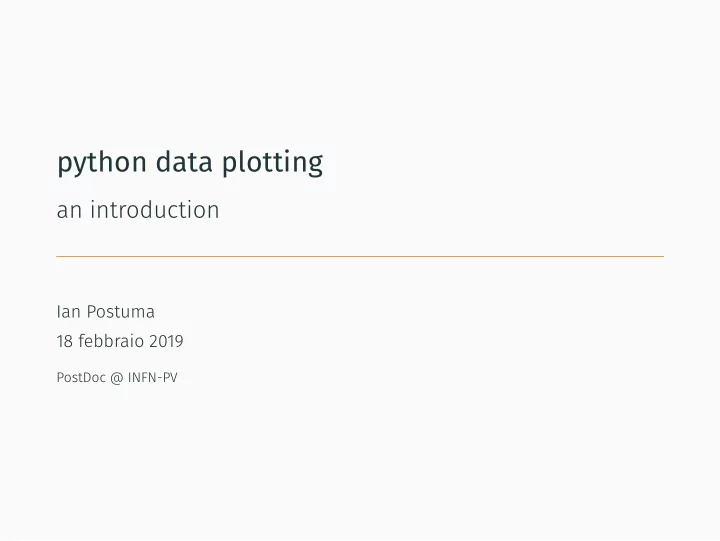

python data plotting an introduction Ian Postuma 18 febbraio 2019 PostDoc @ INFN-PV
Content 1. Introduction 2. Experimental data 3. Python 4. Exercise ian.postuma@pv.infn.it 1
Introduction
Incipit there are n different ways to analyse data, where n is an enormous unsigned int. It is not important which of the n ways you use, what matters is that the final result is correct. ian.postuma@pv.infn.it 2
Some Software Matlab Excel Origin Scidavis ian.postuma@pv.infn.it 3
What you will see today Python Matplotlib Numpy ian.postuma@pv.infn.it 4
Experimental data
Introduction The data that we will use to plot is stored into an ASCII file. –> ir.001 ian.postuma@pv.infn.it 5
Data for the first plot 1.33004 ian.postuma@pv.infn.it ... -21401.844 1.57827 -21559.959 1.49076 -21537.369 1.40811 -21413.137 -21736.895 SMPL: Zona=1 Blocchi=128 1.25629 -21646.545 1.18664 -21925.125 1.12084 -21842.303 1.05870 -21883.715 1.00000 6
Introduction This is the format of the data stored in the first ASCII file that we will use. A second plot will be extracted from another file, we will keep that as an exercise for the second part of the lecture. ian.postuma@pv.infn.it 7
Python
Basic python info Python is an interpreted language, that has legibility and code condensation as it’s main features. On Gnu/Linux systems python is installed by default. Anyhow it doesn’t come with the plotting and data handling packages. In python these are called modules, we will use: matplotlib, scipy and numpy . To install and manage those modules I suggest using pip which is a python module manager, which can be installed by: $ sudo apt-get install python-pip $ sudo pip install --upgrade pip ian.postuma@pv.infn.it 8
modules installation The modules that we need are the ones to: read and manage data (numpy) and to plot (matplotlib). To install these modules it is sufficient to: $ sudo pip install numpy scipy matplotlib ian.postuma@pv.infn.it 9
Other ways to install/use python online -> azure notebook : https://notebooks.azure.com/ which needs a microsoft office account ( usually university/institutions give these accounts for free) windows/mac -> anaconda with python > 3.7 : https://www.anaconda.com/distribution/ ian.postuma@pv.infn.it 10
In the next few slides some python code will be shown. For the ones familiar to C/C++, should be easy to read. ian.postuma@pv.infn.it 10
1 import numpy as np 11 ian.postuma@pv.infn.it plt . show ( ) 15 s t y l e = ’ sci ’ , s c i l i m i t s = ( 0 , 3 ) ) plt . ticklabel_format ( axis = ’ y ’ , 14 (ms) ” ) plt . xlabel ( ” TI 13 ( a . u . ) ” ) plt . ylabel ( ” Signal 12 plt . plot ( x , y , marker= ”o” ) plt . t i t l e ( ” i r .001 ” ) 2 import 10 dpi =300) 9 ) , plt . subplots ( 1 , 1 , f i g s i z e = ( 1 2 , 9 8 7 y = data [ : , 1 ] 6 x = data [ : , 0 ] 5 skiprows =1) 4 data = np . loadtxt ( ” i r .001 ” , 3 plt matplotlib . pyplot as 11
Result ian.postuma@pv.infn.it 12
Let’s see it in Jupyter ian.postuma@pv.infn.it 12
Exercise
For the second plot, you will use the data stored in irA.dat . To read the data from this file, you will need to use the numpy function np.genfromtxt . The following parameters will be useful: • delimiter • skip_header • usecols • skip_footer The x-axis should be plotted in logaritmic scale: xscale(”log”) . To save the image: savefig(’MyIncrediblePictureName.png’) ian.postuma@pv.infn.it 13
Result ian.postuma@pv.infn.it 14
Questions ? ian.postuma@pv.infn.it 14
Recommend
More recommend